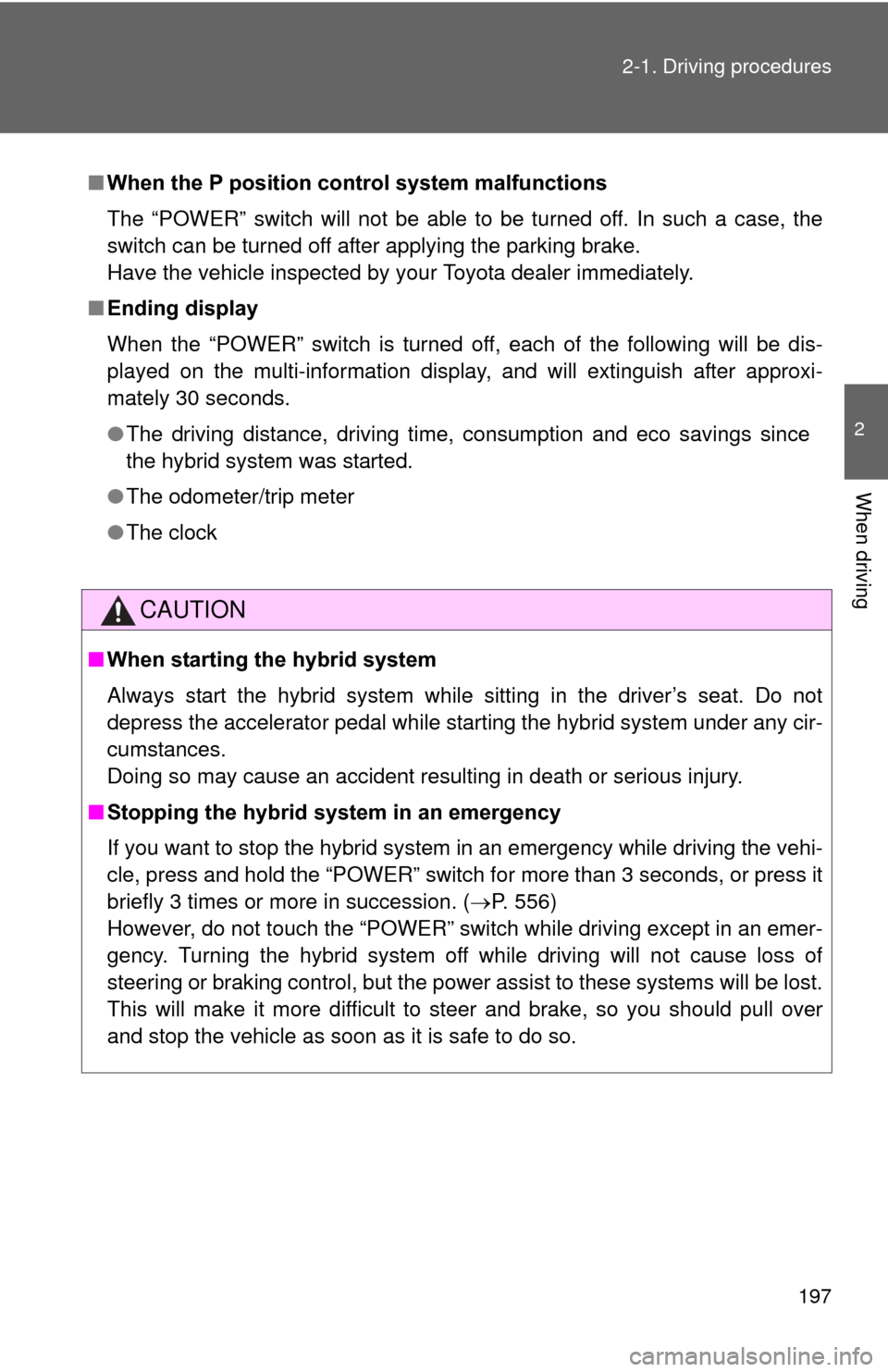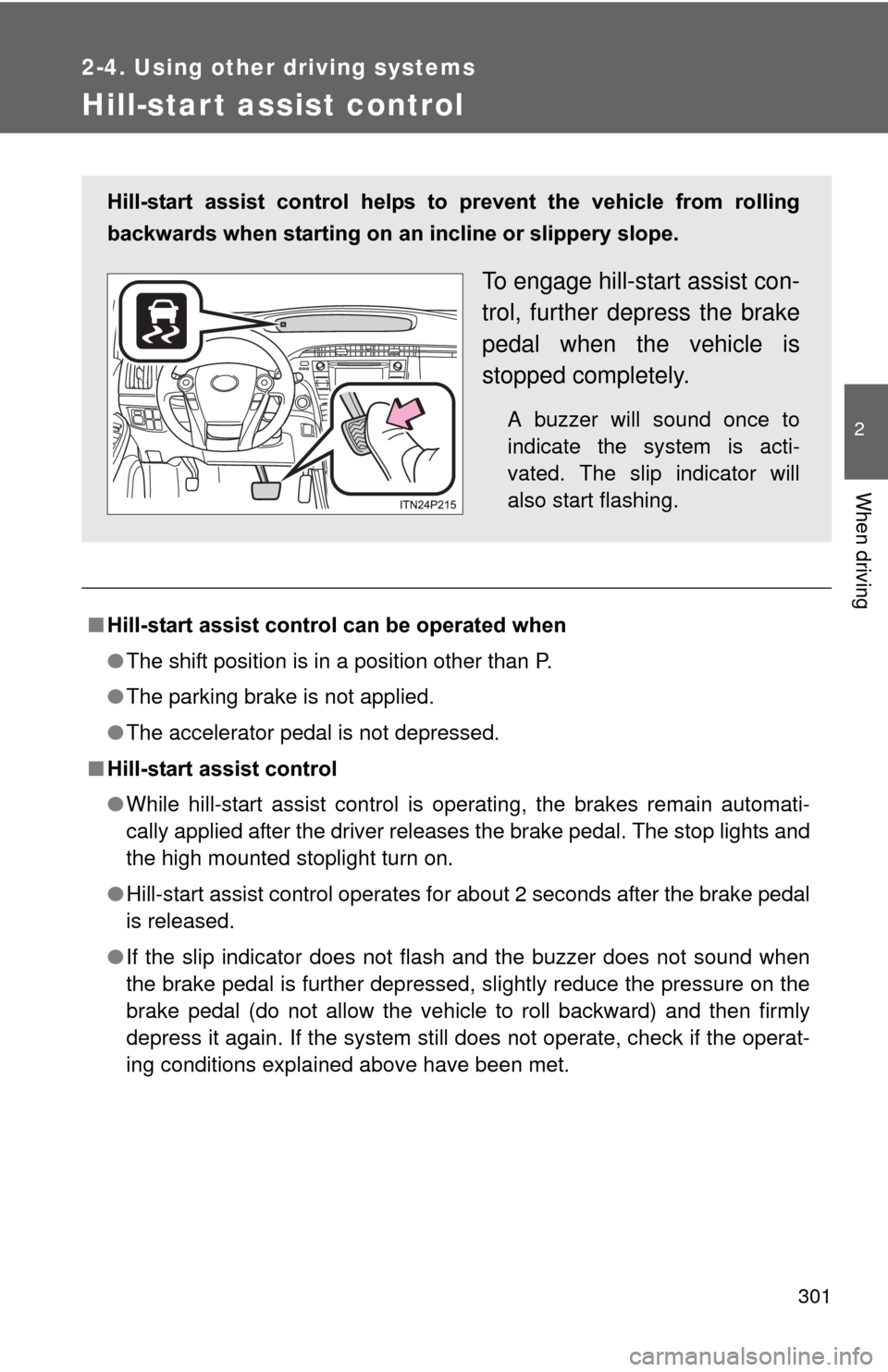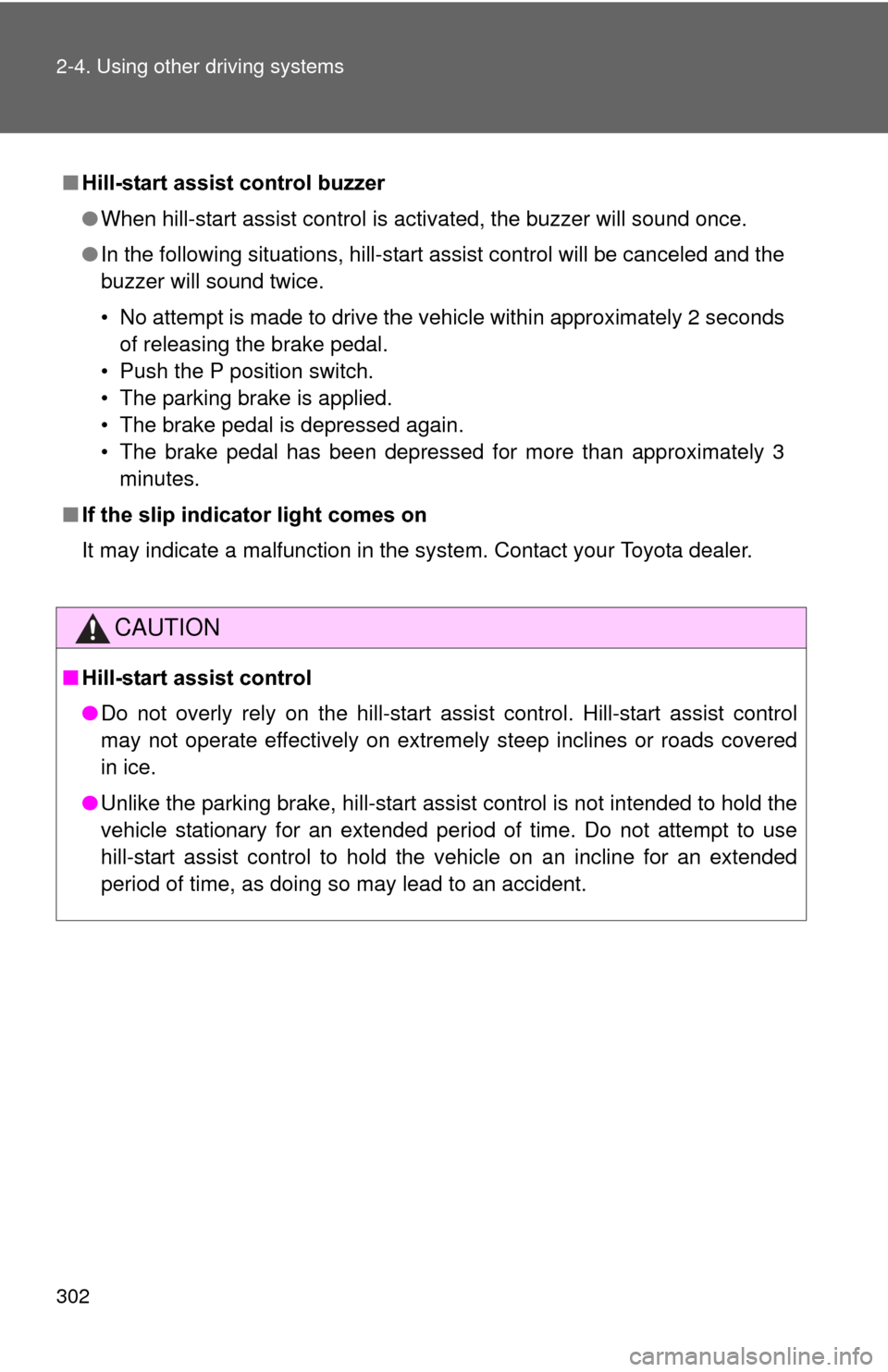2012 TOYOTA PRIUS park assist
[x] Cancel search: park assistPage 3 of 636

1
2
3
4
5
6
7
3
2-1. Driving proceduresDriving the vehicle............... 180
Power (ignition) switch ........ 192
EV drive mode .................... 199
Hybrid transmission ............ 202
Turn signal lever ................. 211
Parking brake ...................... 212
Horn .................................... 213
2-2. Instrument cluster Gauges and meters ............ 214
Indicators and warning lights ................................. 219
Multi-information display ..... 223
Head-up display .................. 243
2-3. Operating the lights and windshield wipers
Headlight switch .................. 250
Fog light switch ................... 256
Windshield wipers and washer .............................. 258
Rear window wiper and washer .............................. 262
Headlight cleaner switch ..... 265 2-4. Using other driving systems
Cruise control ..................... 266
Dynamic radar cruise control .............................. 270
LKA (Lane-Keeping Assist) .............................. 286
Driving assist systems ........ 296
Hill-start assist control ........ 301
PCS (Pre-Collision System) ............................ 303
2-5. Driving information Cargo and luggage ............. 311
Vehicle load limits............... 316
Winter driving tips ............... 317
Trailer towing ...................... 322
Dinghy towing ..................... 323
2When driving
Page 179 of 636

When driving2
179
2-1. Driving proceduresDriving the vehicle............ 180
Power (ignition) switch ..... 192
EV drive mode ................. 199
Hybrid transmission ......... 202
Turn signal lever .............. 211
Parking brake ................... 212
Horn ................................. 213
2-2. Instrument cluster Gauges and meters ......... 214
Indicators and warning lights .............................. 219
Multi-information display............................ 223
Head-up display ............... 243 2-3. Operating the lights and
windshield wipers
Headlight switch ............... 250
Fog light switch ................ 256
Windshield wipers and washer ........................... 258
Rear window wiper and washer ........................... 262
Headlight cleaner switch ............................. 265
2-4. Using other driving systems Cruise control ................... 266
Dynamic radar cruise control ............................ 270
LKA (Lane-Keeping Assist) ............................ 286
Driving assist systems ..... 296
Hill-start assist control ...... 301
PCS (Pre-Collision System).......................... 303
2-5. Driving information Cargo and luggage .......... 311
Vehicle load limits ............ 316
Winter driving tips ............ 317
Trailer towing ................... 322
Dinghy towing .................. 323
Page 181 of 636

181
2-1. Driving procedures
2
When driving
Starting off on a uphill
Firmly set the parking brake with the brake pedal depressed,
and then shift the shift position to D.
Release the brake pedal and gently depress the accelerator
pedal.
Release the parking brake.
■When starting off on a uphill
The hill-start assist control is available. ( P. 301)
■ Driving in the rain
●Drive carefully when it is raining, because visibility will be reduced, the
windows may become fogged-up, and the road will be slippery.
● Drive carefully when it starts to rain, because the road surface will be
especially slippery.
● Refrain from high speeds when driving on an expressway in the rain,
because there may be a layer of water between the tires and the road
surface, preventing the steering and brakes from operating properly.
■ Breaking in your new Toyota
To extend the life of the vehicle, observing the following precautions is rec-
ommended:
●For the first 200 miles (300 km):
Avoid sudden stops.
● For the first 600 miles (1000 km):
• Do not drive at extremely high speeds.
• Avoid sudden acceleration.
• Do not drive at a constant speed for extended periods.
STEP 1
STEP 2
STEP 3
Page 189 of 636

189
2-1. Driving procedures
2
When driving
CAUTION
■
When taking a nap in the vehicle
Always turn the hybrid system off. Otherwise, if you accidentally move the
shift lever or depress the accelerator pedal, this could cause an accident or
fire due to hybrid system overheating. Additionally, if the vehicle is parked in
a poorly ventilated area, exhaust gases may collect and enter the vehicle,
leading to death or a serious health hazard.
■ When braking
●When the brakes are wet, drive more cautiously.
Braking distance increases when the brakes are wet, and this may cause
one side of the vehicle to brake differently than the other side. Also, the
parking brake may not securely hold the vehicle.
● If the electronically controlled assist function does not operate, do not fol-
low other vehicles closely and avoid downhill or sharp turns that require
braking.
In this case, braking is still possible, but the brake pedal should be
depressed more firmly than usual. Also, the braking distance will increase.
● The brake system consists of 2 individual hydraulic systems; if one of the
systems fails, the others will still operate. In this case, the brake pedal
should be depressed more firmly than usual and the braking distance will
increase. If this happens, do not continue to drive the vehicle. If the brake
system warning light (red indicator) comes on while driving, immediately
stop the vehicle in a safe place and contact your Toyota dealer.
Page 197 of 636

197
2-1. Driving procedures
2
When driving
■
When the P position cont rol system malfunctions
The “POWER” switch will not be able to be turned off. In such a case, the
switch can be turned off after applying the parking brake.
Have the vehicle inspected by your Toyota dealer immediately.
■ Ending display
When the “POWER” switch is turned off, each of the following will be dis-
played on the multi-information display, and will extinguish after approxi-
mately 30 seconds.
●The driving distance, driving time, consumption and eco savings since
the hybrid system was started.
● The odometer/trip meter
● The clock
CAUTION
■When starting the hybrid system
Always start the hybrid system while sitting in the driver’s seat. Do not
depress the accelerator pedal while starting the hybrid system under any cir-
cumstances.
Doing so may cause an accident resulting in death or serious injury.
■ Stopping the hybrid system in an emergency
If you want to stop the hybrid system in an emergency while driving the vehi-
cle, press and hold the “POWER” switch for more than 3 seconds, or press it
briefly 3 times or more in succession. ( P. 556)
However, do not touch the “POWER” switch while driving except in an emer-
gency. Turning the hybrid system off while driving will not cause loss of
steering or braking control, but the power assist to these systems will \
be lost.
This will make it more difficult to steer and brake, so you should pull over
and stop the vehicle as soon as it is safe to do so.
Page 291 of 636

291
2-4. Using other
driving systems
2
When driving
■No-handed driving warning
If the steering wheel is not operated for about 15 seconds on a straight road
or about 5 seconds on a curve, the buzzer will beep twice, indicators on the
multi-information display will flash, and the lane keeping assist function will
be temporarily canceled. If you drive the vehicle with your hands lightly
touching the steering wheel, this may also be detected as no-handed driv-
ing.
■ When the vehicle has been parked in the sun
The LKA system functions may not be available for a while after driving has
started. In such cases, turn the LKA system off and turn it on again after nor-
mal temperature returns. When the temperature in the cabin decreases and
the temperature around the camera sensor becomes suitable for its opera-
tion, the functions will begin to operate.
■ Warning lights and warning messages for LKA
Warning lights and messages are used to indicate a system malfunction or
to inform the driver of the need for caution while driving. ( P. 496, 510)
CAUTION
■Before using the LKA system
Do not rely on the LKA system to remain within a selected lane. The LKA
system is not designed to enable inattentive driving. The steering wheel
should be operated by the driver to mainta in the vehicle in a suitable position
within its lane. Always drive carefully.
Page 301 of 636

301
2-4. Using other driving systems
2
When driving
Hill-start assist control
■Hill-start assist control can be operated when
●The shift position is in a position other than P.
● The parking brake is not applied.
● The accelerator pedal is not depressed.
■ Hill-start assist control
●While hill-start assist control is operating, the brakes remain automati-
cally applied after the driver releases the brake pedal. The stop lights and
the high mounted stoplight turn on.
● Hill-start assist control operates for about 2 seconds after the brake pedal
is released.
● If the slip indicator does not flash and the buzzer does not sound when
the brake pedal is further depressed, slightly reduce the pressure on the
brake pedal (do not allow the vehicl e to roll backward) and then firmly
depress it again. If the system still does not operate, check if the operat-
ing conditions explained above have been met.
Hill-start assist control helps to prevent the vehicle from rolling
backwards when starting on an incline or slippery slope.
To engage hill-start assist con-
trol, further depress the brake
pedal when the vehicle is
stopped completely.
A buzzer will sound once to
indicate the system is acti-
vated. The slip indicator will
also start flashing.
Page 302 of 636

302 2-4. Using other driving systems
■Hill-start assist control buzzer
●When hill-start assist control is activated, the buzzer will sound once.
● In the following situations, hill-start assist control will be canceled and the
buzzer will sound twice.
• No attempt is made to drive the vehicle within approximately 2 seconds
of releasing the brake pedal.
• Push the P position switch.
• The parking brake is applied.
• The brake pedal is depressed again.
• The brake pedal has been depressed for more than approximately 3 minutes.
■ If the slip indicator light comes on
It may indicate a malfunction in the system. Contact your Toyota dealer.
CAUTION
■Hill-start assist control
●Do not overly rely on the hill-start assist control. Hill-start assist control
may not operate effectively on extremely steep inclines or roads covered
in ice.
● Unlike the parking brake, hill-start assist control is not intended to hold the
vehicle stationary for an extended period of time. Do not attempt to use
hill-start assist control to hold the vehicle on an incline for an extended
period of time, as doing so may lead to an accident.